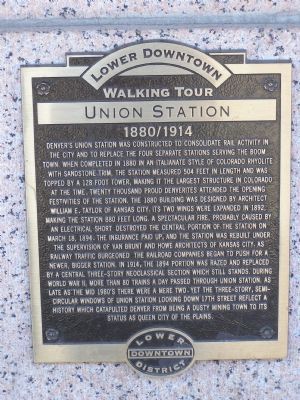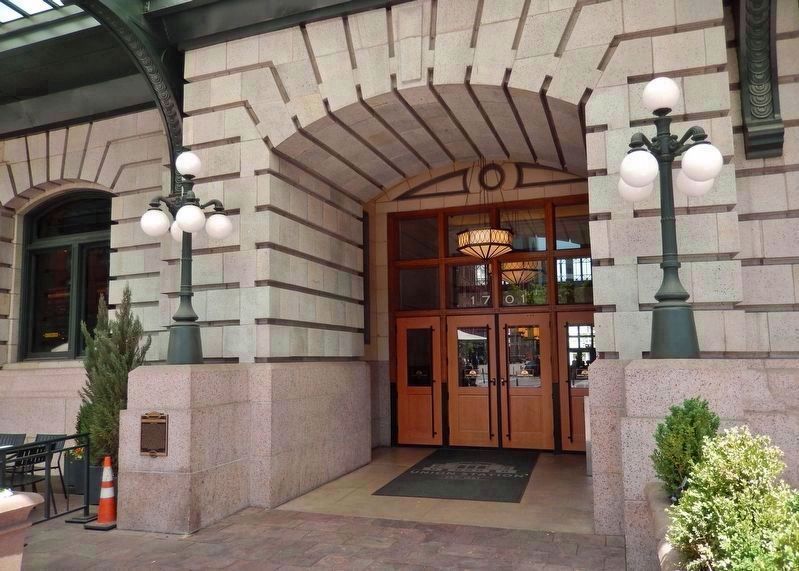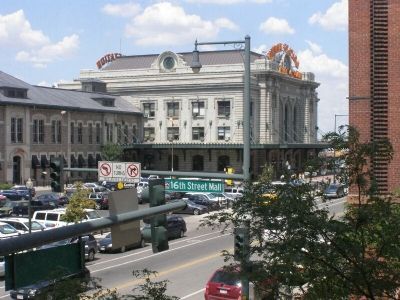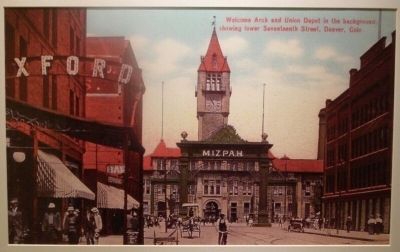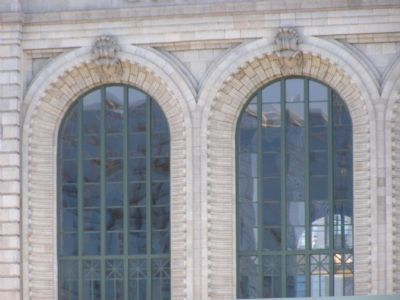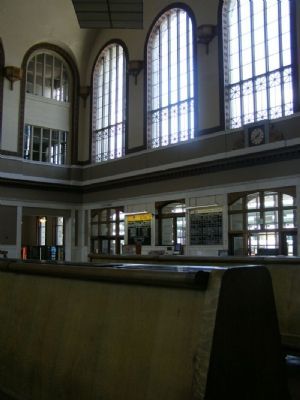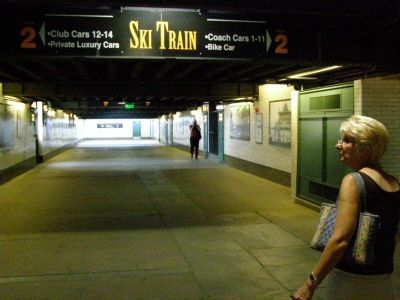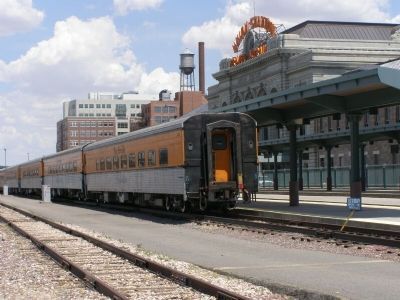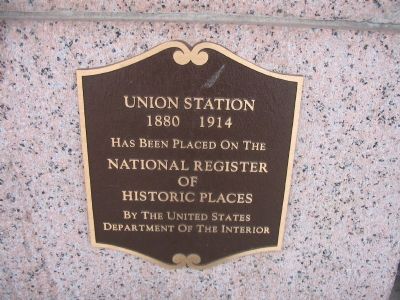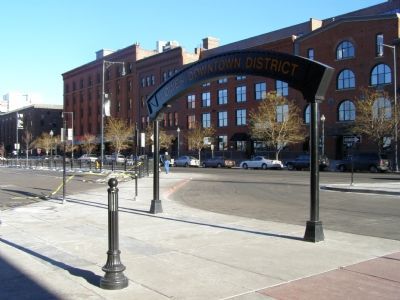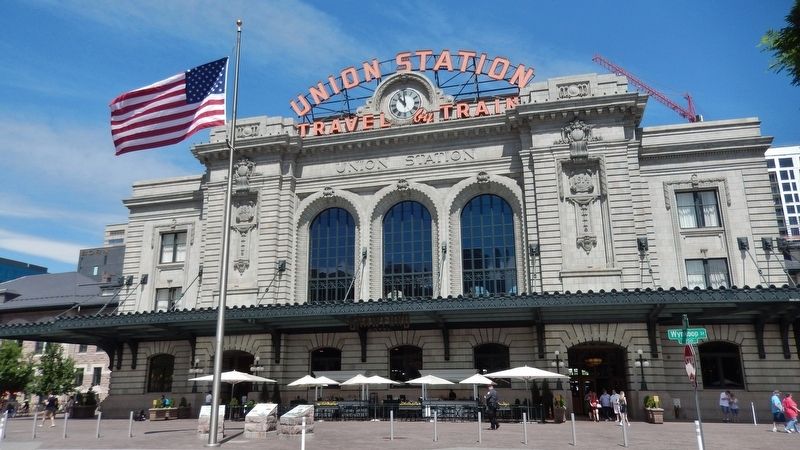Ballpark District in Denver in Denver County, Colorado — The American Mountains (Southwest)
Union Station
1880 / 1914
— Lower Downtown Walking Tour —
Inscription.
Denver's Union Station was constructed to consolidate rail activity in the City and to replace the four separate stations serving the boom town. When completed in 1890 in an Italianate style of Colorado Rhyolite with sandstone trim, the station measured 504 feet in length and was topped by a 128 foot tower, making it the largest structure in Colorado at the time. Twenty thousand proud Denverites attended the opening festivities of the station. The 1880 building was designed by Architect William E. Taylor of Kansas City. Its two wings were expanded in 1892, making the station 880 feet long. A spectacular fire, probably caused by an electrical short destroyed the central portion of the station on March 18, 1894. The insurance paid up, and the station was rebuilt under the supervision of Van Brunt and Howe Architects of Kansas City. As railway traffic burgeoned the railroad companies began to push for a newer, bigger station. In 1914, the 1894 portion was razed and replaced by a central three-story Neoclassical section which still stands. During World War II, more than 80 trains a day passed through Union Station. As late as the mid 1980's there were a mere two. Yet the three-story semi-circular windows of Union Station looking down 17th Street reflect a history which catapulted Denver from being a dusty mining town to its status as Queen
City of the Plains.
Erected by Lower Downtown District.
Topics. This historical marker is listed in these topic lists: Notable Buildings • Notable Events • Railroads & Streetcars. A significant historical date for this entry is March 18, 1894.
Location. 39° 45.187′ N, 104° 59.986′ W. Marker is in Denver, Colorado, in Denver County. It is in the Ballpark District. Marker is on Wynkoop Street near 17th Street. Out front of the building to the right as approaching up 17th street. Touch for map. Marker is at or near this postal address: 1701 Wynkoop Street, Denver CO 80202, United States of America. Touch for directions.
Other nearby markers. At least 8 other markers are within walking distance of this marker. The People of the Station (a few steps from this marker); Welcome to Union Station (a few steps from this marker); Union Station Timeline (within shouting distance of this marker); Union Station Area (within shouting distance of this marker); Denver City Railway Building (within shouting distance of this marker); When the Depot Became a Station (within shouting distance of this marker); Edward W. Wynkoop (within shouting distance of this marker); Warehouses (about 300 feet away, measured in a direct line). Touch for a list and map of all markers in Denver.
Related markers. Click here for a list of markers that are related to this marker. Denver Union Station
Additional commentary.
1. Denver's Famous Mizpah Arch (see picture 3)
In 1906, Denver's Famous Mizpah Arch was built in front of Union Station on 17th Street between Wynkoop and Wazee Streets. The 70-ton bronze-coated, steel gateway supported a huge "WELCOME" sign, illuminated by 2,194 light bulbs. Denver's Mayor Speer officially dedicated the arch on July 4th, 1906, declaring that it "is to stand here for ages as an expression of love, good wishes, and kind feelings of our citizens to the stranger who enters our gates."
Initially the arch also said "WELCOME" on the downtown side, but the Chamber of Commerce belatedly realized that departing visitors should not be "WELCOME" to leave Denver. Chamber officials later replaced that side of the sign with the word "MIZPAH".
Local Denver citizens initially told visitors that it was an "Indian Word" for "Howdy, Partner." In reality, mizpah is the Hebrew parting salutation found in Genesis 31-49; 'The Lord watch between me and thee, when we are absent one from another."
For how famous the Mizpah Arch is in Denver history, it only stood for a brief 25 years. The Mizpah Arch was taken down on December 7th, 1931 after being deemed a traffic hazard.
— Submitted January 9, 2008.
2. Brief History of Denver Union Station
1870 - The first train arrived in Denver's Central Platte Valley on June 21, 1870. At that time, only four small temporary stations were set up to serve passengers.
1881 - The Union Depot and Railroad Company built the city's first Union Station. It cost $525,000 and opened on June 1, 1881.
1894 - The original Union Station building burned on March 18, 1894, when a fire ignited the electrical system of the ladies' restroom. Damage was considerable. The building's wooden tower was destroyed. Union Station was quickly rebuilt with a much lower roofline and a stone clock tower replaced the wooden one.
1906 - Denver's famous Welcome or Mizpah Arch was built in front of Union Station on 17th Street between Wynkoop and Wazee streets; the arch was formally dedicated on July 4, 1906.
1914 - In 1914, the Denver Union Terminal Railway Company tore down the stone clock tower and replaced with the building's lower expanded center section that you see to this day. The original chandeliers were eight feet across. The original sconces on the wall were under coats of paint for decades. Only recently were they restored to their original bronze tone. The plaster arches that line the walls of the center room have 2300 carved Columbine flowers in them.
1920s/30s - The 1920s and 1930s were the glory days of Denver Union Station. During
that time, the station operated 80 trains a day.
1931 - The Mizpah arch was taken down on December 7, 1931 after being deemed a traffic hazard. Presidents Eisenhower, Taft and Theodore Roosevelt are just a few of the famous people who came by train into Union Station.
1958 - Up until 1958, Denver Union Station had more travelers than Stapleton Airport.
Late 1980s - In the late 1980s, the Regional Transportation District (RTD) and the City of Denver cooperated with the Denver Union terminal Railway Corporation (DUT), the private owner of the terminal, to make improvements to the site. These improvements included upgrading rail platforms and canopies and accommodating an RTD bus lane to access Market Street Station from the I-25 bus/High Occupancy Vehicle (HOV) lanes.
1997-2000 - RTD, the City and the Denver Regional Council of Governments (DRCOG) cooperated with the Union Station Transport Development Company (USTDC) and various private landowners and businesses to create the Central Platte Valley Light Rail Spur (C-Line), a major public transit connection to DUS.
2001 - In August 2001, RTD purchased the site in accordance with a jointly funded Intergovernmental Agreement between RTD, the City and County of Denver (CCD), CDOT and DRCOG.
2002 - In May 2002, the Denver Union Station project team was initiated by the CCD, RTD, CDOT, and DRCOG to develop a Master Plan and prepare an Environmental Impact Statement (EIS) for Union Station.
Source: RTD and Denver Union Terminal Supervisor
— Submitted January 9, 2008, by Kevin W. of Stafford, Virginia.
Credits. This page was last revised on December 7, 2023. It was originally submitted on January 9, 2008, by Christopher Light of Valparaiso, Indiana. This page has been viewed 5,932 times since then and 85 times this year. Last updated on December 5, 2023, by Carl Gordon Moore Jr. of North East, Maryland. Photos: 1. submitted on January 9, 2008, by Christopher Light of Valparaiso, Indiana. 2. submitted on June 11, 2018, by Cosmos Mariner of Cape Canaveral, Florida. 3, 4, 5, 6, 7, 8. submitted on January 9, 2008, by Christopher Light of Valparaiso, Indiana. 9. submitted on January 9, 2008, by Kevin W. of Stafford, Virginia. 10. submitted on January 9, 2008, by Christopher Light of Valparaiso, Indiana. 11. submitted on June 11, 2018, by Cosmos Mariner of Cape Canaveral, Florida. • J. Makali Bruton was the editor who published this page.
